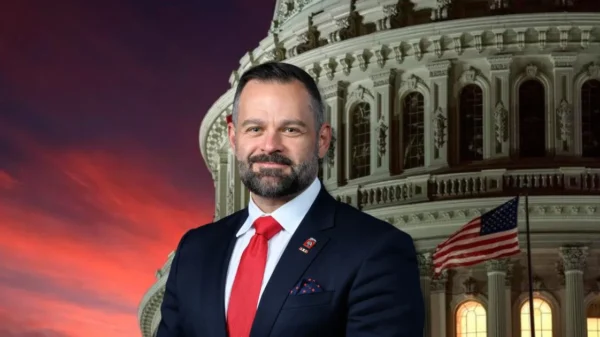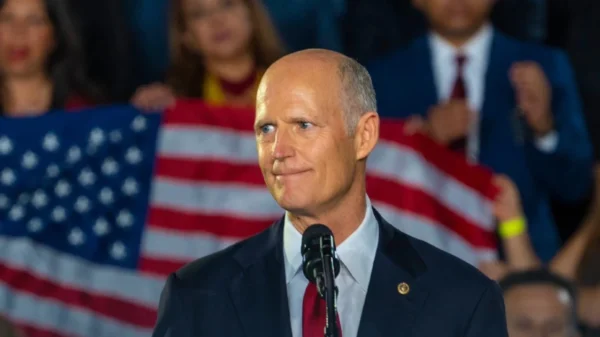This week, U.S. Rep. Brian Mast, R-Fla., offered testimony in the U.S. House Subcommittee on Energy and Water Appropriations.
His remarks, as prepared for delivery, are below:
Chairman Fleischmann and Ranking Member Kaptur, thank you for the opportunity to speak to your panel today. This is what is at stake for my community – this disgusting sludge has been sent into our water. I’ll spare you all, but it absolutely reeks. But the smell is the least of our worries. This is toxic, plain and simple. It’s been linked to ALS, Alzheimer’s disease, kidney disease, tumors, etc. It’s killed pets, shut down businesses, and turned our piece of paradise into a toxic nightmare.
Congress – and your committee in particular – has a chance to fix it. For the last several years, this committee has shown an incredible commitment to South Florida Everglades restoration by providing record levels of funding, and it’s never wasted. Every dollar allocated is put to work. In the last year alone, the Herbert Hoover Dike and the C-43 Reservoir have been completed. These projects were massive, years-long endeavors that are now protecting South Floridians from flooding and improving water quality in the region.
But our work is far from done. The Everglades Agricultural Area Reservoir, or the EAA Reservoir, has been rightly called the heart of the Everglades, as it is the single most important project when it comes to Everglades restoration. When completed, it will hold 240,000-acre-feet of water from Lake Okeechobee and send it south to the Everglades when it is needed. The project will recharge the Florida Aquifer to provide water for millions of South Floridians, bring in millions of dollars through tourism, protect a one-of-a-kind ecosystem, and provide public health and ecological relief to millions of people.
The Army Corps and the South Florida Water Management District, the Corps’ cost-sharing partner, have broken ground on the project, but it still faces constant delays. This year, several contracts will be awarded for the reservoir, which means ample funding is needed to keep the project moving forward. I cannot emphasize this enough – my community cannot wait any longer for this project to be completed. The State of Florida has done an outstanding job in prioritizing funding for the EAA Reservoir, but the federal government has not matched its commitment. Every year that Congress fails to provide the funding called for in the Integrated Delivery Schedule is another year the Everglades are starved of water and the east and west coasts of Florida are used as toilets to flush this toxic crap through our waterways.
There is bipartisan recognition among my South Florida colleagues, and we are united in supporting the highest possible funding for the South Florida Ecosystem Restoration account, and I will specifically request an additional $310 million in funding above President Biden’s request of $415 million. That brings the total to $725 million, in line with what has been called for in the Army Corps’ IDS. The longer it takes to complete the EAA REservoir, the more expensive this project will get for the taxpayers. I’d ask for this subcommittee to include the full $725 million so that we can keep the momentum going.
We need to be responsible with the taxpayer dollars, and it is my opinion that we should not be funding “clean energy demonstrations” or “educational grants” under the Bureau of Reclamation, while my community is being poisoned. I will be following up with the committee with proposed adjustments to funding in order to ensure we are, in fact, being responsible with taxpayer funds.
In the remainder of my time, I’d like to highlight two other Community Project Funding Requests I have made to this subcommittee: the first is funding for an environmental infrastructure program included in WRDA 2022. This $1.5 million will fund projects in three estuaries that are plagued with ecological issues. Based on the extremely successful project in the Florida Keys, St. Lucie, Martin, and Palm Beach Counties would be able to partner with the Army Corps to address water infrastructure shortcomings that lead to nutrients flowing into our waterways and fueling harmful algal blooms.
The second CPF request is $400,000 for the Army Corps to begin the feasibility study for the Northern Estuaries Restoration Plan. While projects like the EAA Reservoir will provide relief for communities on both coasts, its completion won’t end harmful discharges from Lake Okeechobee. It will only address two-thirds of the discharges both coasts receive, meaning more work is needed to fully restore the Greater Everglades ecosystem. The Northern Estuaries Restoration Plan is the first step in addressing this next phase.
Thank you again for all that you’ve done to support my community’s fight for clean water. For us, the money provided to these projects doesn’t just keep the Treasure Coast beautiful – it makes it a safe and healthy place to call home. I look forward to continuing our work to that end.


















